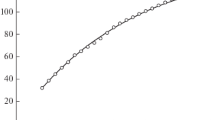Summary
Growth of the Antarctic krill, Euphausia superba, is not easily determined from net catches nor from laboratory experiments. Therefore, in support of these methods, a phenomenological model was constructed which in its present state describes the growth of a single krill specimen under periodically limiting food conditions with summer seasons of variable lengths. Published data of krill body length vs. age and of the annual cycle of primary production of algae in the Drake Passage were used to formulate equations and to calculate growth curves. At 1,000 days after hatching, the model predicts a body length of 63 mm, growth being delayed by 380 days compared with constant, optimal feeding conditions. Final length, weight and time delay are related to the amount of food supplied and compared with published population growth curves.
Similar content being viewed by others
References
Bertalanffy L von (1951) Theoretische Biologie, Band II, Stoffwechsel, Wachstum. A Francke, Bern, 418 pp
Boysen E (1982) Untersuchungen an einer Population des nordischen Krills Meganyctiphanes norvegica (M. Sars) im Kattegat. M Sc Thesis, University Kiel, 92 pp
Boysen E, Buchholz F (1984) Meganyctiphanes norvegica in the Kattegat. Studies on the annual development of a pelagic population. Mar Biol 79:195–207
Buchholz F (1985) Moulting and growth in Euphausiids. In: Siegfried WR, Laws RM, Condy PR (eds) Antarctic nutrient cycles and food webs (Proc 4th SCAR Symp Antarct Biol). Springer, Berlin, pp 339–345
El-Sayed SZ (1968) On the productivity of the southwest Atlantic Ocean and the waters west of the Antarctic Peninsula. In: Schmitt WL, Llano GA (eds) Biology of the Antarctic Seas III (Antarct Res Ser 11:15–47)
Everson I (1977) The living resources of the Southern Ocean. Southern Ocean Fisheries Survey Programme GLO/SO/77/1 FAO, Rome, 156 pp
Fraser FC (1936) On the development and distribution of the young stages of krill (Euphausia superba). Discovery Rep 14:3–192
Hempel I, Hempel G (1978) Larval krill (Euphausia superba) in the plankton and neuston samples of the German Antarctic Expedition 1975/76. Meeresforsch 26:206–216
Ikeda T, Dixon P (1982) Observations on moulting in Antarctic krill (Euphausia superba Dana). Aust J Mar Freshwater Res 33:71–76
Ivanov BG (1970) On the biology of the Anterctic krill Euphausia superba. Mar Biol 7:340–351
Jazdzewski K, Dzik J, Porebski J, Rakusa-Suszczewski S, Witek Z, Wolnomiejski N (1978) Biological and populational studies on krill near South Shetland Islands, Scotia Sea and South Georgia in the summer 1976. Pol Arch Hydrobiol 25:607–631
Kikuno T (1982) Observations of early developments of the Antarctic krill, Euphausia superba Dana. In: Hoshiai T, Naito Y (eds) Proc 5th Symp Antarct Biol. Memoirs of National Institute of Polar Research, Tokyo, pp 38–43
Krüger F (1973) Zur Mathematik des tierischen Wachstums. 2. Vergleich einiger Wachstumsfunktionen. Helgol Wiss Meeresunters 25:509–550
Mackintosh NA (1972) Life cycle of Antarctic krill in relation to ice and water conditions. Discovery Rep 36:1–94
Majkowski J, Uchmański J (1980) Theoretical foundations of individual growth equations in animals. Pol Ecol Stud 6:7–31
Makarov RR Larval development of theAntarctic euphausiids. BIOMASS handbook 3, 13 pp
Marschall H-P, Hirche H-J (1984) Development of eggs and nauplii of Euphausia superba. Polar Biol 2:245–250
Mauchline J (1980) The biology of mysids and euphausiids. Adv Mar Biol 18:373–595
Mauchline J, Fisher LR (1969) The biology of euphausiids. Adv Mar Biol 7:1–454
McWhinnie MA, Denys C (1978) Biological studies of Antarctic krill, austral summer 1977–78. Antarc J US 13:133–135
Nast F (1978/79) The vertical distribution of larval and adult krill (Euphausia superba Dana) on a time station south of Elephant Island, South Shetlands. Meeresforsch 27:101–118
Winberg GG (1971) Methods for the estimation of production of aquatic animals. Academic Press, London New York, 175 pp
Witek Z, Koronkiewicz A, Soszka GJ (1980) Certain aspects of the early life history of krill Euphausia superba Dana (Crustacea). Pol Polar Res 1:97–115
Author information
Authors and Affiliations
Rights and permissions
About this article
Cite this article
Astheimer, H., Krause, H. & Rakusa-Suszczewski, S. Modelling individual growth of the Antarctic krill Euphausia superba Dana. Polar Biol 4, 65–73 (1985). https://doi.org/10.1007/BF00442902
Received:
Accepted:
Issue Date:
DOI: https://doi.org/10.1007/BF00442902




